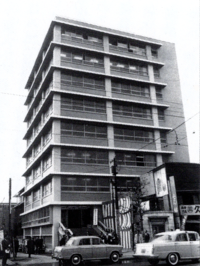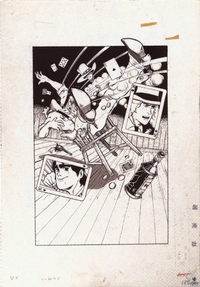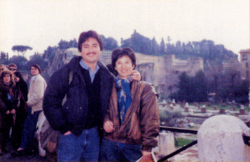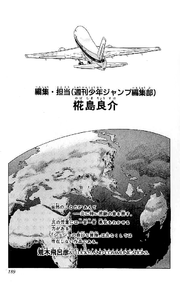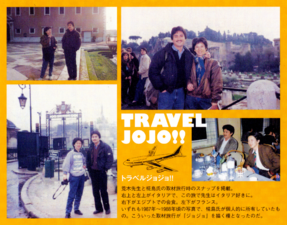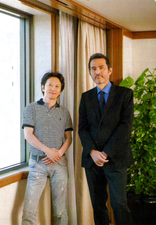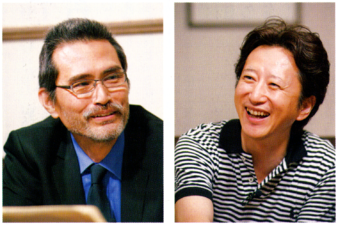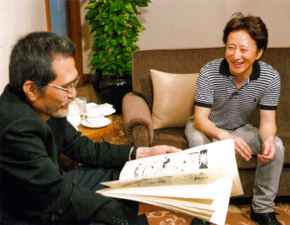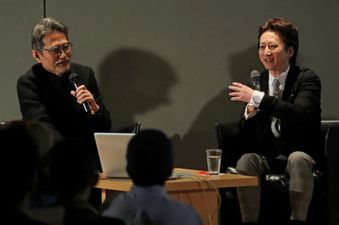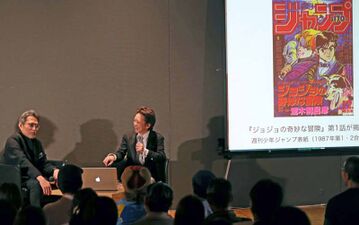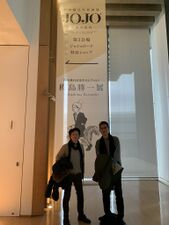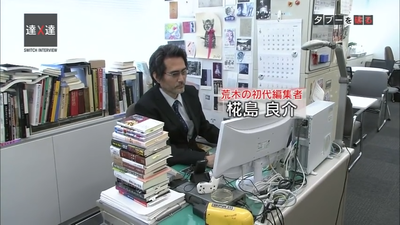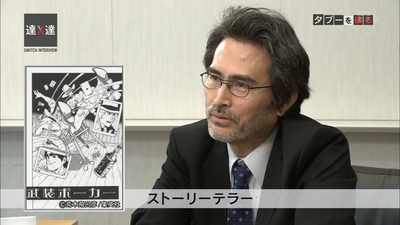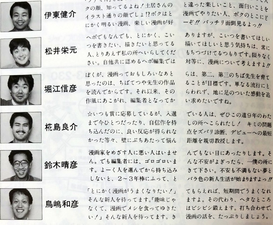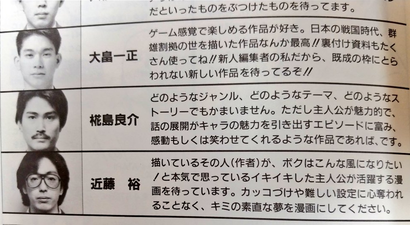ریوسکه کاباشیما

|
Note: This is a user's personal page attached to their profile! This is not an actual article, may not be related to JoJo or Araki, and is not associated with the wiki. As such, it may not adhere to the policies. |
ریوسکه کاباشیما (椛島良介, Kabashima Ryōsuke) نخستین ویراستار آقای هیروهیکو آراکی بود که در رشد ایشان به عنوان یک هنرمند مانگا در ده سال آغازین حرفهاش نقش بسزایی بازی کرده. مشارکت او از سال ۱۹۷۹ تا پایان استارداست کروسیدرز[1] در ۱۹۹۲ ادامه داشت.
کاباشیما در حال حاضر یکی از مشاورین شرکت شوئیشا است اما قبل از آن مدیر اجرایی شوئیشا بینالملل بود. در گذشته او نقشهایی مانند مدیرعامل بخش ویراستاری شینشو از شوئیشا، بنیانگذار و سردبیرِ مانگا آلمَن و ویرایشگر در هفتهنامه شونن جامپ و سوپر جامپ را نیز بر عهده داشته است. اون نوهی هنرمند کمیک پیشگام ژاپنی، کاتسوایچی کاباشیما، است.
تاریخچه
مسیر به ویراستار شدن
کاباشیما در موروران، هوکّایدو ژاپن در سال ۱۹۵۴ به دنیا آمد اما در دو سالگی به توکیو مهاجرت کرد. او از شوهِی چوجو، در حال حاضر پروفسور دانشگاهی که با هم به راهنمایی و دبیرستان رفتهاند، به عنوان یکی از بزرگترین الهاماتش یاد میکند. چوجو ژانر موسیقی جَز و کارهای رماننویسهایی همچون تاتسوهیکو شیبوساوا و یوکیو میشیما را به او معرفی کرد. جالب اینجاست که کاباشیما موقع بزرگ شدن مانگا نمیخواند و فقط گاکی دِکا از هفتهنامهی شونن چَمپیون را در دانشگاه مطالعه میکرد. پیش از ویراستار شدن، او در رابطه با باستانشناسی و تاریخ دنیای غرب تحصیل میکرد.
در سال ۱۹۷۹، کاباشیما به یکی از بزرگترین ناشرهای ژاپن، شوئیشا، درخواست کار کرد؛ صرفا بخاطر اینکه "کمپانی به نظرش باحال میومد و ماهنامهی پلِیبوی تازه منتشرشدهشان برایش بسیار جذاب بود". او به طور غیرمنتظرانه، به بخش ویراستاری هفتهنامهی شونن جامپ پیوست در حالی که هیچوقت مجلهاش را نخوانده بود. او در آوریل سال ۱۹۷۹ در جامپ شروع به کار کرد، در کنار نوبوهیکو هوریه، ویراستار مشت ستاره شمالی. در آن زمان، بخش ویراستاری جامپ حدود ده دوازده نفر کارکن داشت، با شیگِئو نیشیمورا به عنوان سردبیر نسل سوم. در همین اوقات سیرکت نو اوکامی به تازگی به اتمام رسیده بود و سری کیننیکومان شروع به انتشار کرده بود. رینگ نی کاکِروی ماسامی کورومادا هم داشت به اوج معروفیت خود میرسید، اما کاباشیما در حالی که هیچ مانگای جامپی نخوانده بود، نمیتوانست دلیلش را درک کند.
آشنایی با آراکی
Kabashima had only been an editor for a few months when he first met Araki in 1979. At the time, Araki's manga submissions were constantly rejected by various publishing companies, spurring him to go straight to Shueisha's editorial building to get some answers. Kabashima, Horie, and a few other newer editors were the only ones there at the time as the senior editors only worked later in the day. It was around noon when Araki arrived and Kabashima, who was coincidently walking to the receptionist desk, ended up being the first to critique Araki's submission. According to Araki, Kabashima was extremely severe and pointed out each of Araki's technical faults (from having forgotten to erase pen lines to leaking white-outs). However, he sensed potential in Araki's work and told him to fix his pages and apply for the upcoming Tezuka Awards. Araki's submission, Poker Under Arms, won the runner-up prize and would go on to be his first published manga.[2]
Before JoJo
Kabashima subsequently became Araki's editor and worked with him on his earliest publications. As a horror and suspense fan, he enjoyed Araki's early works and often encouraged him to avoid doing what was popular among other Jump titles. Kabashima also defended Araki's 1983 series, Cool Shock B.T., and advocated its publication despite the other editors' disapproval of its Japanese name (Devil Boy) and eccentric content.[3] It was around this time that Kabashima began encouraging Araki to travel abroad, which resulted in Araki's first overseas trip from London to Paris.[1]
After B.T.'s serialization, Kabashima assisted Araki in renting a Tokyo apartment for a year. By living in the same city as Shueisha's editorial building, Araki no longer needed to commute every week and could focus more time on his next series, Baoh the Visitor. During its short run, Kabashima was adamant about improving Araki's weekly schedule management, which included getting enough sleep and taking breaks on Fridays and Saturdays. Kabashima set aside these off-days, particularly so Araki could gather material through experiencing other media. It was thanks to this schedule that Araki could go to the movie theaters almost every week, sometimes with Kabashima tagging along. Their weekly meetings were also very film-related as the two would typically discuss work on the actual manga for around 30 minutes and then casually talk about movies and novels for 2 hours. They shared an interest in horror, so Kabashima often recommended and rented out horror films for Araki to check out for inspiration.[1]
JoJo's Bizarre Adventure
The name "JoJo" was derived at a Denny's where Kabashima and Araki had their first meeting pertaining to the series.[1] The two had decided on "Jonathan" as the series' protagonist, however, Araki also wanted the initials to match in a way similar to the American filmmaker, Steven Spielberg (S.S). They eventually landed on the name, "Jonathan Joestar" (J.J) and thus the nickname "JoJo" was born.[4] Their later meetings during Part 2 and Part 3 would ironically be at a "Jonathan's Family Restaurant" as it was closer to Araki's workplace.
Kabashima notes that Part 1 was not popular during its publication due to being a standard "fighting manga" with a "foreign" protagonist, which was considered taboo. He constantly had to defend the series from cancellation due to Shueisha's strict "if it's not popular, cut it off" policy back then. However, the editor-in-chief at the time allowed it to continue because he valued Araki's storytelling and B.T did particularly well in ratings towards the end of its publication. Kabashima also explains that while Jonathan as the hero was a bit rough at first, bringing in characters like Zeppeli and Speedwagon created a comradery dynamic that resonated a lot more with the readers.[1]
In 1987, Kabashima invited a very reluctant Araki to go on a trip with him to Egypt. The latter was under the impression that Egypt was a country with a "dirty" image and was not particularly interested in going there, but was convinced by Kabashima none-the-less. Araki recalls reading on the plane the "Encyclopedia of Modern Murder" by Colin Wilson, a book Kabashima had recommended to him prior. It was on this trip, specifically during a boat tour of the Nile, that Araki came up with the idea of DIO being in Egypt. During Part 2's publication, the two would continue to travel together to other countries like Italy or France.[1]
Kabashima admits that he rarely had to make corrections when it came to Part 3. In previous parts, he often gave Araki suggestions that would help push JoJo's ratings, but once Stands were introduced, the series became insanely popular and the need to suggest anything disappeared. He would, however, continue to point out panels that were hard to understand visually and Araki had to redraw them. With how little Kabashima had to correct, the 30-minutes of their "work discussion" they had each meeting was cut even shorter and filled with more discussion of movies.[1]
Kabashima was in charge of JoJo up until the end of Part 3, after which he was transferred to "Super Jump," another of Shueisha's magazine lines. Araki recalls feeling very uneasy at the time as he had never had another editor before, but Kabashima knew the series was stable enough at that point and trusted Araki to continue the steady workflow they developed.[1] After Super Jump, Kabashima would go on to become the founder and editor-in-chief of MANGA ALLMAN, then the head director of Shueisha's Shinsho editorial department, then the managing director of Shueisha International, and is now currently one of Shueisha's company advisors.[5] Despite leaving, Kabashima would continue to oversee Araki's other works that were published in Super Jump and Allman, including various one-shots from Under Execution, Under Jailbreak and The Lives of Eccentrics.
Interviews
Gallery
References
- ↑ 1.0 1.1 1.2 1.3 1.4 1.5 1.6 1.7 JOJOVELLER: History 1979-2013
- ↑ Cite error: Invalid
<ref>tag; no text was provided for refs namedtokai - ↑ Hirohiko Araki's Manga Technique, Chapter 3, Resistance to a Devil Boy
- ↑ Phantom Blood PS2 (October 2006)
- ↑ Cite error: Invalid
<ref>tag; no text was provided for refs namedjojonicle
